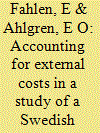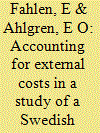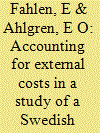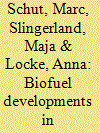|
|
|
Sort Order |
|
|
|
Items / Page
|
|
|
|
|
|
|
| Srl | Item |
| 1 |
ID:
098264


|
|
|
|
|
| Publication |
2010.
|
| Summary/Abstract |
Sweden has historically had strict emission control by implementation of economic policy instruments with the aim of internalising the external costs of air pollution. This study aims to evaluate how well current Swedish policy instruments reflect the environmental costs associated with heat generation in several district-heating (DH) plants in the DH system of Göteborg. Furthermore, it aims to simulate and evaluate the operation of the DH system based on its social cost-effectiveness which takes into account the DH system's private and external costs (non-internalised environmental costs). The study shows that the economic policy instruments do not fully internalise all external costs whereas for certain technologies, the costs in terms of taxes, emission permits, environmental fees, etc. are higher than the environmental costs caused by the pollutants, given the environmental cost estimates used in the study. The simulation results show that the deviating internalisation of external costs affects the economic ranking of the different plants within the studied DH system. The estimated loss in social-cost effectiveness of the operation of the DH system of Göteborg is noticable but relatively small if compared to the variable heat generation costs for most of the studied DH plants.
|
|
|
|
|
|
|
|
|
|
|
|
|
|
|
|
| 2 |
ID:
098560


|
|
|
|
|
| Publication |
2010.
|
| Summary/Abstract |
Sweden has historically had strict emission control by implementation of economic policy instruments with the aim of internalising the external costs of air pollution. This study aims to evaluate how well current Swedish policy instruments reflect the environmental costs associated with heat generation in several district-heating (DH) plants in the DH system of Göteborg. Furthermore, it aims to simulate and evaluate the operation of the DH system based on its social cost-effectiveness which takes into account the DH system's private and external costs (non-internalised environmental costs). The study shows that the economic policy instruments do not fully internalise all external costs whereas for certain technologies, the costs in terms of taxes, emission permits, environmental fees, etc. are higher than the environmental costs caused by the pollutants, given the environmental cost estimates used in the study. The simulation results show that the deviating internalisation of external costs affects the economic ranking of the different plants within the studied DH system. The estimated loss in social-cost effectiveness of the operation of the DH system of Göteborg is noticable but relatively small if compared to the variable heat generation costs for most of the studied DH plants.
|
|
|
|
|
|
|
|
|
|
|
|
|
|
|
|
| 3 |
ID:
098576


|
|
|
|
|
| Publication |
2010.
|
| Summary/Abstract |
Sweden has historically had strict emission control by implementation of economic policy instruments with the aim of internalising the external costs of air pollution. This study aims to evaluate how well current Swedish policy instruments reflect the environmental costs associated with heat generation in several district-heating (DH) plants in the DH system of Göteborg. Furthermore, it aims to simulate and evaluate the operation of the DH system based on its social cost-effectiveness which takes into account the DH system's private and external costs (non-internalised environmental costs). The study shows that the economic policy instruments do not fully internalise all external costs whereas for certain technologies, the costs in terms of taxes, emission permits, environmental fees, etc. are higher than the environmental costs caused by the pollutants, given the environmental cost estimates used in the study. The simulation results show that the deviating internalisation of external costs affects the economic ranking of the different plants within the studied DH system. The estimated loss in social-cost effectiveness of the operation of the DH system of Göteborg is noticable but relatively small if compared to the variable heat generation costs for most of the studied DH plants.
|
|
|
|
|
|
|
|
|
|
|
|
|
|
|
|
| 4 |
ID:
098582


|
|
|
|
|
| Publication |
2010.
|
| Summary/Abstract |
CO2 emissions reduction, renewable energy deployment and energy efficiency are three main energy/environmental goals, particularly in Europe. Their relevance has led to the implementation of support schemes in these realms. Their coexistence may lead to overlaps, synergies and conflicts between them. The aim of this paper is to analyse the interactions between energy efficiency measures and renewable energy promotion, whereas previous analyses have focused on the interactions between emissions trading schemes (ETS) and energy efficiency measures and ETS and renewable energy promotion schemes. Furthermore, the analysis in this paper transcends the "certificate" debate (i.e., tradable green and white certificates) and considers other instruments, particularly feed-in tariffs for renewable electricity. The goal is to identify positive and negative interactions between energy efficiency and renewable electricity promotion and to assess whether the choice of specific instruments and design elements within those instruments affects the results of the interactions.
|
|
|
|
|
|
|
|
|
|
|
|
|
|
|
|
| 5 |
ID:
098275


|
|
|
|
|
| Publication |
2010.
|
| Summary/Abstract |
CO2 emissions reduction, renewable energy deployment and energy efficiency are three main energy/environmental goals, particularly in Europe. Their relevance has led to the implementation of support schemes in these realms. Their coexistence may lead to overlaps, synergies and conflicts between them. The aim of this paper is to analyse the interactions between energy efficiency measures and renewable energy promotion, whereas previous analyses have focused on the interactions between emissions trading schemes (ETS) and energy efficiency measures and ETS and renewable energy promotion schemes. Furthermore, the analysis in this paper transcends the "certificate" debate (i.e., tradable green and white certificates) and considers other instruments, particularly feed-in tariffs for renewable electricity. The goal is to identify positive and negative interactions between energy efficiency and renewable electricity promotion and to assess whether the choice of specific instruments and design elements within those instruments affects the results of the interactions.
|
|
|
|
|
|
|
|
|
|
|
|
|
|
|
|
| 6 |
ID:
098595


|
|
|
|
|
| Publication |
2010.
|
| Summary/Abstract |
Under an entry-exit gas tariff system, reservation of capacity is split into entry capacity, to transport gas from the injection points to a virtual balancing point, and exit capacity, to transport gas from the balancing point to the exit points in the system.
Entry-exit tariff for gas transport systems have been recommended by the 3rd EU Energy Package, since they are cost reflective, facilitate gas trade and can provide signals for the location of gas injections or off-takes. The advisability of applying an entry-exit tariff system is discussed in this paper.
Apart from this, authors propose an entry-exit tariff model and apply it to compute charges for the Spanish gas transport system in 2009. Results produced by the model are presented as coefficients which should multiply the current postal transport tariff.
The paper concludes that entry-exit tariffs would be useful location signals which would result in a better use of the gas transport system in Spain. In those cases where demand exceeds available capacity, as it occurs at the congested connection with France, entry-exit tariffs could be supplemented by capacity charges at entry points resulting from auctions.
|
|
|
|
|
|
|
|
|
|
|
|
|
|
|
|
| 7 |
ID:
098614


|
|
|
|
|
| Publication |
2010.
|
| Summary/Abstract |
The Energy Independence and Security Act (EISA) of 2007 requires life-cycle assessment (LCA) for quantifying greenhouse gas emissions (GHGs) from expanded U.S. biofuel production. To qualify under the Renewable Fuel Standard, cellulosic ethanol and new corn ethanol must demonstrate 60% and 20% lower emissions than petroleum fuels, respectively. A combined corn-grain and corn-stover ethanol system could potentially satisfy a major portion of renewable fuel production goals. This work examines multiple LCA allocation procedures for a hypothetical system producing ethanol from both corn grain and corn stover. Allocation choice is known to strongly influence GHG emission results for corn-ethanol. Stover-derived ethanol production further complicates allocation practices because additional products result from the same corn production system. This study measures the carbon intensity of ethanol fuels against EISA limits using multiple allocation approaches. Allocation decisions are shown to be paramount. Under varying approaches, carbon intensity for corn ethanol was 36-79% that of gasoline, while carbon intensity for stover-derived ethanol was -10% to 44% that of gasoline. Producing corn-stover ethanol dramatically reduced carbon intensity for corn-grain ethanol, because substantially more ethanol is produced with only minor increases in emissions. Regulatory considerations for applying LCA are discussed.
|
|
|
|
|
|
|
|
|
|
|
|
|
|
|
|
| 8 |
ID:
098625


|
|
|
|
|
| Publication |
2010.
|
| Summary/Abstract |
This paper identifies the potential for concentrated solar power (CSP) to generate electricity in a rural region of Western Australia. A review of policies designed to stimulate the contribution of renewable sources highlights the continued reliance upon fossil fuels to supply current and future electricity needs in Australia. Potential CSP sites are defined in the Wheatbelt region of Western Australia through overlaying environmental variables and electricity infrastructure on a high resolution grid using widely available datasets and standard geographical information system (GIS) software. The analysis confirms that CSP facilities can be sited over large areas of the Wheatbelt which can be tailored to local patterns of supply and demand. The research underlines the necessity to develop a policy regime which actively supports and stimulates CSP in order to capitalize upon its potential to facilitate rural economic development while contributing towards greenhouse gas emission reduction targets.
|
|
|
|
|
|
|
|
|
|
|
|
|
|
|
|
| 9 |
ID:
098597


|
|
|
|
|
| Publication |
2010.
|
| Summary/Abstract |
Climate change, rising oil prices and concerns about future energy supplies have contributed to a growing interest in using biomass for energy purposes. Several studies have highlighted the biophysical potential of biofuel production on the African continent, and analysts see Mozambique as one of the most promising African countries. Favorable growing conditions and the availability of land, water and labor are mentioned as major drivers behind this potential. Moreover, the potential of biofuel production to generate socio-economic benefits is reflected in the government's policy objectives for the development of the sector, such as reducing fuel import dependency and creating rural employment. This article provides an overview of biofuel developments in Mozambique and explores to what extent reality matches the suggested potential in the country.
We conclude that biofuel developments mainly take place in areas near good infrastructure, processing and storage facilities, where there is (skilled) labor available, and access to services and goods. Moreover, our analysis shows the need to timely harmonize current trends in biofuel developments with the government's policy objectives as the majority of existing and planned projects are not focusing on remote rural areas, and - in absence of domestic markets - principally target external markets.
|
|
|
|
|
|
|
|
|
|
|
|
|
|
|
|
| 10 |
ID:
098611


|
|
|
|
|
| Publication |
2010.
|
| Summary/Abstract |
Cadmium telluride photovoltaic (CdTe PV) technology is growing rapidly, and already represents the largest contributor to non-silicon based photovoltaics worldwide. We assessed the extent to which CdTe PV will play a notable role in the Cd use and emission flows in the future, and whether it will be environmentally beneficial or detrimental. Our results show that while CdTe PV may account for a large percentage of future global Cd demand, its role in terms of Cd sequestration may be beneficial. We calculated that its potential contribution to yearly global Cd emissions to air and water may well be orders-of-magnitude lower than the respective current Cd emissions rates in Europe.
|
|
|
|
|
|
|
|
|
|
|
|
|
|
|
|
| 11 |
ID:
098622


|
|
|
|
|
| Publication |
2010.
|
| Summary/Abstract |
This paper investigates the competition effects of the entry of Vattenfall into the German electricity market. While the competition authorities supported the entry by approving Vattenfall's acquisition of three regional utilities, other market participants raised concerns over the emergence of an upcoming oligopoly in the German market for power generation. We contrast the efficiency hypothesis postulating pro-competitive effects of mergers with the market power hypothesis postulating anti-competitive effects. For the analysis of the two opposing hypotheses, we use an event study approach to the stock prices of Vattenfall's competitors in the German market. While we find no empirical evidence for increased market power in the German electricity market due to Vattenfall's mergers, there is some indication for efficiency increases. We therefore cannot oppose the view of the competition authorities predicting an overall positive effect for consumers as a result of Vattenfall's entry into the German electricity market.
|
|
|
|
|
|
|
|
|
|
|
|
|
|
|
|
| 12 |
ID:
098558


|
|
|
|
|
| Publication |
2010.
|
| Summary/Abstract |
In 1987, the UK Conservative Party was re-elected promising to transform the electricity industry into a privatised competitive industry and to promote an expansion of nuclear power. Fulfilling both objectives was not possible. The nuclear plants were withdrawn from the sale and plans to build new plants were abandoned, but privatisation proceeded. In 2007, the Labour government began a new attempt to build nuclear plants to operate in the competitive electricity market, promising that no subsidies would be offered to them. By 2010, the utilities that were planning to build nuclear plants were beginning to suggest that 'support' in some form would be needed if they were to build new plants. More surprisingly, the energy regulator, Ofgem, cast doubt on whether a competitive wholesale electricity market would provide security of supply. In 1990, the UK government opted for a competitive electricity market over expanding nuclear power. Now, the option of opting for a competitive electricity market may not exist. However, this might not leave the way open for new nuclear plants. The expected cost of power from new nuclear plants is now so high that no more than one or two heavily subsidised plants will be built.
|
|
|
|
|
|
|
|
|
|
|
|
|
|
|
|
| 13 |
ID:
098262


|
|
|
|
|
| Publication |
2010.
|
| Summary/Abstract |
In 1987, the UK Conservative Party was re-elected promising to transform the electricity industry into a privatised competitive industry and to promote an expansion of nuclear power. Fulfilling both objectives was not possible. The nuclear plants were withdrawn from the sale and plans to build new plants were abandoned, but privatisation proceeded. In 2007, the Labour government began a new attempt to build nuclear plants to operate in the competitive electricity market, promising that no subsidies would be offered to them. By 2010, the utilities that were planning to build nuclear plants were beginning to suggest that 'support' in some form would be needed if they were to build new plants. More surprisingly, the energy regulator, Ofgem, cast doubt on whether a competitive wholesale electricity market would provide security of supply. In 1990, the UK government opted for a competitive electricity market over expanding nuclear power. Now, the option of opting for a competitive electricity market may not exist. However, this might not leave the way open for new nuclear plants. The expected cost of power from new nuclear plants is now so high that no more than one or two heavily subsidised plants will be built.
|
|
|
|
|
|
|
|
|
|
|
|
|
|
|
|
| 14 |
ID:
098598


|
|
|
|
|
| Publication |
2010.
|
| Summary/Abstract |
The Kyoto Protocol allocates tradable emission allowances (AAUs) to developed countries, but they are free to choose a set of policy instruments to comply with these targets. We compare two different policy instruments: a tax and purely domestic tradable permits, for the European Union, the US and Japan. Information on abatement costs and international permit price is imperfect and stems from nine global economic models. For a country party to the Protocol, the benefit of emission reduction is that it can sell more or has to buy less AAUs. We show that in this context, permits entail a slightly lower expected cost than a tax for the US and Japan, whereas both instruments yield an almost equal outcome for Europe. Applying Weitzman's framework (Prices vs. quantities, RES, 1974) in this context, we show the importance of the positive correlation between costs and benefits: technology shocks that lead to low abatement costs in one country generally lead to low abatement costs in other countries too, thereby leading to a low international permit price in the true-up period.
|
|
|
|
|
|
|
|
|
|
|
|
|
|
|
|
| 15 |
ID:
098603


|
|
|
|
|
| Publication |
2010.
|
| Summary/Abstract |
The paper reviews the history and the economics of the French PWR program, which is arguably the most successful nuclear-scale up experience in an industrialized country. Key to this success was a unique institutional framework that allowed for centralized decision making, a high degree of standardization, and regulatory stability, epitomized by comparatively short reactor construction times.
Drawing on largely unknown public records, the paper reveals for the first time both absolute as well as yearly and specific reactor costs and their evolution over time. Its most significant finding is that even this most successful nuclear scale-up was characterized by a substantial escalation of real-term construction costs. Conversely, operating costs have remained remarkably flat, despite lowered load factors resulting from the need for load modulation in a system where base-load nuclear power plants supply three quarters of electricity.
The French nuclear case illustrates the perils of the assumption of robust learning effects resulting in lowered costs over time in the scale-up of large-scale, complex new energy supply technologies. The uncertainties in anticipated learning effects of new technologies might be much larger that often assumed, including also cases of "negative learning" in which specific costs increase rather than decrease with accumulated experience.
|
|
|
|
|
|
|
|
|
|
|
|
|
|
|
|
| 16 |
ID:
098253


|
|
|
|
|
| Publication |
2010.
|
| Summary/Abstract |
Small and open economic systems like cities face specific challenges for greenhouse gas accounting. They typically import most of their energy requirements as secondary energy products based on conversion processes which caused emissions elsewhere. Emission estimates therefore already require attention not only to direct on-site activities. Moreover, for a comprehensive approach it is suggested to include upstream and downstream processes of connected socioeconomic systems and the indirect life-cycle related emissions of imported and exported goods.
Singapore is used in this longitudinal study as an example of an urban scale economy. Accounts for direct emissions are compared with trade corrected estimates of indirect emissions. Results indicate that direct emissions account for only about 20% of the overall upstream emissions necessary to sustain the input side of the economic production process (domestic emissions plus indirect emissions embodied in imported goods). If indirect emissions embodied in exports are considered and subtracted from the previous figure, the trade corrected accounts for direct and indirect emissions still exceed direct emission accounts, although by less than 40%. Given the increasing trends in world trade and urbanisation, indirect pressures of urban systems should be included in discussions of effective and fair adaptation and mitigation strategies.
|
|
|
|
|
|
|
|
|
|
|
|
|
|
|
|
| 17 |
ID:
098548


|
|
|
|
|
| Publication |
2010.
|
| Summary/Abstract |
Small and open economic systems like cities face specific challenges for greenhouse gas accounting. They typically import most of their energy requirements as secondary energy products based on conversion processes which caused emissions elsewhere. Emission estimates therefore already require attention not only to direct on-site activities. Moreover, for a comprehensive approach it is suggested to include upstream and downstream processes of connected socioeconomic systems and the indirect life-cycle related emissions of imported and exported goods.
Singapore is used in this longitudinal study as an example of an urban scale economy. Accounts for direct emissions are compared with trade corrected estimates of indirect emissions. Results indicate that direct emissions account for only about 20% of the overall upstream emissions necessary to sustain the input side of the economic production process (domestic emissions plus indirect emissions embodied in imported goods). If indirect emissions embodied in exports are considered and subtracted from the previous figure, the trade corrected accounts for direct and indirect emissions still exceed direct emission accounts, although by less than 40%. Given the increasing trends in world trade and urbanisation, indirect pressures of urban systems should be included in discussions of effective and fair adaptation and mitigation strategies.
|
|
|
|
|
|
|
|
|
|
|
|
|
|
|
|
| 18 |
ID:
098591


|
|
|
|
|
| Publication |
2010.
|
| Summary/Abstract |
The data from the project "Conviver," launched in 2006 in Belo Horizonte (Brazil), provides a unique opportunity to study illegal electricity connections. Based on an original dataset of 15,279 low-income households, this paper studies the incidence and determinants of illegality in the context of low-income urban favelas. The probability of engaging in illegal behavior is explained not just by low income, but by a combination of concurring factors: sub-standard energy provision and equipment; inefficient/incorrect use of domestic electric appliances and running an informal in-house business. These recurrent issues in the urban favelas aggravate a sense of exclusion from growth, which is generally recognized as a trigger of illegality. The impact of energy demand on energy-related illegality is carefully analyzed, and different empirical strategies adopted to circumvent some simultaneity problem between both decision processes. The effectiveness of consumption-based energy subsidies is also explored. In spite of some contrary arguments in the literature, in the context of peri-urban slums, such measures may exert a positive impact in mitigating illegal access and use of energy. Effectiveness will be enhanced by accompanying measures such as: perceivable improvements of equipment, metering and maintenance, promotion of beneficiaries' awareness of energy usage, and energy-saving behaviors.
|
|
|
|
|
|
|
|
|
|
|
|
|
|
|
|
| 19 |
ID:
098214


|
|
|
|
|
| Publication |
2010.
|
| Summary/Abstract |
Global concern with climate change has led to the development of a variety of solutions to monitor and reduce emissions on both local and global scales. Under the United Nations Framework Convention on Climate Change (UNFCCC), both developed and emerging countries have assumed responsibility for developing and updating national inventories of greenhouse gas emissions from anthropic sources. This creates opportunities and incentives for cities to carry out their own local inventories and, thereby, develop air quality management plans including both essential key players and stakeholders at the local level. The aim of this paper is to discuss the role of local inventories as an urban public policy instrument and how this type of local instrument may bring advantages countrywide in enhancing the global position of a country. Local inventories have been carried out in many cities of the world and the main advantage of this is that it allows an overview of emissions produced by different municipal activities, thereby, helps decision makers in the elaboration of efficient air quality management plans. In that way, measures aimed at the reduction of fossil fuel consumption to lower local atmospheric pollution levels can also, in some ways, reduce GHG emissions.
|
|
|
|
|
|
|
|
|
|
|
|
|
|
|
|
| 20 |
ID:
098547


|
|
|
|
|
| Summary/Abstract |
Global concern with climate change has led to the development of a variety of solutions to monitor and reduce emissions on both local and global scales. Under the United Nations Framework Convention on Climate Change (UNFCCC), both developed and emerging countries have assumed responsibility for developing and updating national inventories of greenhouse gas emissions from anthropic sources. This creates opportunities and incentives for cities to carry out their own local inventories and, thereby, develop air quality management plans including both essential key players and stakeholders at the local level. The aim of this paper is to discuss the role of local inventories as an urban public policy instrument and how this type of local instrument may bring advantages countrywide in enhancing the global position of a country. Local inventories have been carried out in many cities of the world and the main advantage of this is that it allows an overview of emissions produced by different municipal activities, thereby, helps decision makers in the elaboration of efficient air quality management plans. In that way, measures aimed at the reduction of fossil fuel consumption to lower local atmospheric pollution levels can also, in some ways, reduce GHG emissions.
|
|
|
|
|
|
|
|
|
|
|
|
|
|
|
|
|
|
|
|
|